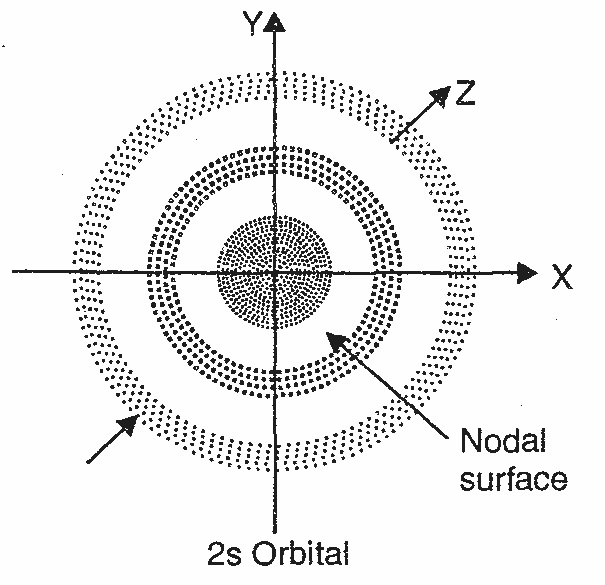Concept of Orbital:
According to wave mechanical approach, we can not say simply that the electron exists at a particular point but we talk about certain regions in space around the nucleus where the probability of finding electron is maximum. Such regions are called orbital wave function or orbital. Therefore, an orbital is the region or parts in space around the nucleus where the probability of finding electron is maximum.
 Quantum Numbers:
Quantum Numbers:
An electron in an atom has some location relative to the nucleus and is associated with a definite amount of energy. These properties are taken together to describe the state of electron in an atom. In order to determine the position and energy of an electron completely, a set of four index number is required. These sets of four index numbers are called quantum numbers. These are as follows-
1) Principal quantum number (n)
2) Azimuthal quantum number (l)
3) Magnetic quantum number (m)
4) Spin quantum number (s)
Principal quantum number (n):
It determines the energy levels in which the electron is revolving round the nucleus and is also known as major energy level. It is denoted by the symbol n and may have any integral value except zero. n = 1,2,3,4, etc., denote that the electron is in the first (K), second (L), third (M), fourth (N) shell etc. respectively. As the distance of the electron from the nucleus increases, its energy becomes higher and higher. The maximum number of electrons in a major energy level is 2n2. Therefore,
Value of n 1 2 3 4 …..
Shell designation: K L M N …..
Max. no. of electrons (2n2) 2 8 18 32 …..
Note: the energy of various level follow the sequence, K<L<M<N<P<O ….etc
Azimuthal or orbital quantum number (l):
It is denoted by the symbol l and gives the sub-shell to which the electron belongs as also its angular momentum in its motion around the nucleus. It may have any value ranging from 0 to (n-1).
When n = 1, l can have only one value, l=0 l = (n-1)
When n = 2, l can have two values, l=0 and l=1.
When n = 3, l can have three values, l=0, l=1 and l=2.
The sub-shells corresponding to l=0, 1, 2, 3, are the s, p, d and f sub-shells respectively. For example when n =3 and l=2 the electron is said to be in 3d sub-shell.
Magnetic quantum number (m):
It is denoted by the symbol m and accounts for the splitting up of spectral lines into a number of components when the source is put under a strong magnetic field (Zeeman Effect) or electric field (Stark Effect) which in other words means that each sublevel exists as a number of closely related levels which are revealed only in a magnetic field. The magnetic quantum number gives the location of the orbit of revolution of the electron in the sub-shell. The possible value which m can have depends upon the value of l and may assume all the integral values between +l to –l through zero i.e. the total number of values of m would be (2l+1).
When l= 0, m =0 (only one value).
When l = 1, m may have three values m = -1, m = 0, m = +1.
When l = 2, m may have five values m = -2, -1, 0, +1, +2.
Total number of m values indicates the total number of orbitals into which a particular s, p, d or f sub-shell is sub divided.
Spin quantum number (s):
It is denoted by the symbol s and arise from the spectral evidence that an electron rotates or spins about its own axis as well during its motion in an orbit around the nucleus. The electron may spin in the clockwise (↓) direction or anticlockwise (↑) direction and only two values of s are possible viz. +1/2 (for clockwise) and -1/2 (for anticlockwise).
Two electrons with the same sign of spin are said to have parallel spin and are represented as ↑↑ while those having opposite spin are said to have antiparallel spin represented as ↓↑ and are known as paired up electrons.